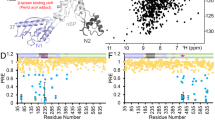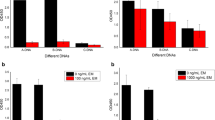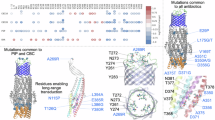Abstract
Macrolide biosensor protein MphR(A) has been known as a key regulatory protein in metabolite sensing and genetic expression regulating. MphR(A) protein binds to macrolide antibiotic erythromycin (Ery) and releases the gene operon, thus activates expression of the mphA gene and initiates Ery resistance. The two mutant amino acid residues (V66L and V126L) might potentially disrupt Ery binding to MphR(A). In these studies, the binding of macrolide antibiotic Ery to wild type (Wt) MphR(A) and double mutant (V66L/V126L) MphR(A) are explored by molecular dynamics simulations. Compared to the Apo-MphR(A) protein and Wt-MphR(A)–Ery complex, many interesting effects owing to the double mutant (V66L/V126L) are discovered. In the case of Ery, Helix I which plays an important role in transcription shows itself a right-hand α helix in Wt-MphR(A)–Ery, whereas the activated helix is broken down in double mutant-V66L/V126L-MphR(A)–Ery. The calculated results exhibit that the double mutant V66L/V126L reduces the binding affinity of the V66L/V126L-MphR(A) to Ery, resulting in the block of Ery resistance. The binding free energy decomposition analysis reveals that the decrease of the binding affinity for the variant V66L/V126L-MphR(A)–Ery is mainly attributed to the gas phase electrostatic energies. The residue Leu66, Thr154, and Arg122 enhance the binding affinity of V66L/V126L-MphR(A) to Ery. The residues Tyr103 and His147 contributes mainly to binding energies in the Wt-MphR(A)–Ery complex, whereas the two residues have no contribution to the binding free energy inV66L/V126L-MphR(A)–Ery complex. Our study gives useful insights into the nature of amino acids mutation effect, the mechanism of blocking drug resistance at the atomic level and the characteristics in binding affinity for Ery to double mutant (V66L/V126L) MphR(A), which will contribute to the design of more effective macrolide antibiotics.











Similar content being viewed by others
References
Beatson SA, Walker MJ (2014) Tracking antibiotic resistance. Science 345(6203):1454–1455
Gopinath S et al (2014) Role of disease-associated tolerance in infectious superspreaders. Proc Natl Acad Sci USA 111(44):15780–15785
Takakusagi K et al (2015) Multimodal biopanning of T7 phage-displayed peptides reveals angiomotin as a potential receptor of the anti-angiogenic macrolide Roxithromycin. Eur J Med Chem 90:809–821
Waters V, Ratjen F (2014) Antibiotic treatment for nontuberculous mycobacteria lung infection in people with cystic fibrosis. Cochrane Database Syst Rev (12):CD010004
Al-Taie O, Al-Taie E, Fischbach W (2014) Patients with Helicobacter pylori negative gastric marginal zone b-cell lymphoma (MZBCL) of MALT have a good prognosis. Z Gastroenterol 52(12):1389–1393
Zheng JT et al (2009) Structure and function of the macrolide biosensor protein, MphR(A), with and without erythromycin. J Mol Biol 387(5):1250–1260
Poor AE et al (2014) Control of multi-drug-resistant pathogens with non-thermal-plasma-treated alginate wound dressing. Surgical Infections 15(3):233–243
Szczepanowski R et al (2007) Novel macrolide resistance module carried by the IncP-1 beta resistance plasmid pRSB111, isolated from a wastewater treatment plant. Antimicrob Agents Chemother 51(2):673–678
Schumacher MA et al (2001) Structural mechanisms of QacR induction and multidrug recognition. Science 294(5549):2158–2163
Fuentes MAF et al (2014) Antimicrobial resistance determinants in antibiotic and biocide-resistant gram-negative bacteria from organic foods. Food Control 37:9–14
Marti E, Balcazar JL (2012) Multidrug resistance-encoding plasmid from Aeromonas sp strain P2G1. Clin Microbiol Infect 18(9):E366–E368
Kannan K, Vazquez-Laslop N, Mankin AS (2012) Selective protein synthesis by ribosomes with a drug-obstructed exit tunnel. Cell 151(3):508–520
Noguchi N et al (2000) Regulation of transcription of the mph(A) gene for macrolide 2′-phosphotransferase I in Escherichia coli: characterization of the regulatory gene mphR(A). J Bacteriol 182(18):5052–5058
Yu HY et al. (2011) Novel Regulator MphX represses activation of phenol hydroxylase genes caused by a XylR/DmpR-type regulator MphR in Acinetobacter calcoaceticus. Plos One 6(3):e17350
Petersson GA et al (2003) On the optimization of Gaussian basis sets. J Chem Phys 118(3):1101–1109
Kodchakorn K et al (2014) GPU accelerated molecular dynamics simulations for protein-protein interaction of ankyrin complex. Integr Ferroelectr 156(1):137–146
Case DA et al (2005) The Amber biomolecular simulation programs. J Comput Chem 26(16):1668–1688
Spasic A, Serafini J, Mathews DH (2012) The amber ff99 force field predicts relative free energy changes for RNA helix formation. J Chem Theory Comput 8(7):2497–2505
Li D et al (2014) Investigation on the mechanism for the binding and drug resistance of wild type and mutations of G86 residue in HIV-1 protease complexed with Darunavir by molecular dynamic simulation and free energy calculation. J Mol Model 20(2):2122
Nikitin AM, Milchevskiy YV, Lyubartsev AP (2014) A new AMBER-compatible force field parameter set for alkanes. J Mol Model 20(3):2143
Salomon-Ferrer R, Case DA, Walker RC (2013) An overview of the Amber biomolecular simulation package. Wiley Interdiscip Rev Comput Mol Sci 3(2):198–210
Steinbrecher T, Latzer J, Case DA (2012) Revised AMBER parameters for bioorganic phosphates. J Chem Theory Comput 8(11):4405–4412
Pearlman DA et al (1995) Amber, a package of computer-programs for applying molecular mechanics, normal-mode analysis, molecular-dynamics and free-energy calculations to simulate the structural and energetic properties of molecules. Comput Phys Commun 91(1–3):1–41
Simonson T, Carlsson J, Case DA (2004) Proton binding to proteins: pK(a) calculations with explicit and implicit solvent models. J Am Chem Soc 126(13):4167–4180
Greenidge PA et al (2013) MM/GBSA binding energy prediction on the PDBbind data set: successes, failures, and directions for further improvement. J Chem Inf Model 53(1):201–209
Godschalk F et al (2013) Comparison of MM/GBSA calculations based on explicit and implicit solvent simulations. Phys Chem Chem Phys 15(20):7731–7739
Singh MK, Dominy BN (2010) Thermodynamic resolution: how do errors in modeled protein structures affect binding affinity predictions? Proteins Struct Funct Bioinf 78(7):1613–1617
Deshmukh SA et al (2013) Atomistic insights into solvation dynamics and conformational transformation in thermo-sensitive and non-thermo-sensitive oligomers. Polymer 54(1):210–222
Pitera JW (2014) Expected distributions of root-mean-square positional deviations in proteins. J Phys Chem B 118(24):6526–6530
Kalmankar NV, Ramakrishnan C, Balaram P (2014) Sparsely populated residue conformations in protein structures: revisiting “experimental” Ramachandran maps. Proteins Struct Funct Bioinf 82(7):1101–1112
Noguchi N et al (2000) Regulation of transcription of the mph(A) gene for macrolide 2’-phosphotransferase I in Escherichia coli: characterization of the regulatory gene mphR(A). J Bacteriol 182(18):5052–5058
Miller BR et al (2012) MMPBSA.py: an efficient program for end-state free energy calculations. J Chem Theory Comput 8(9):3314–3321
Sun HM, Hunter CA, Llamas EM (2015) The flexibility-complementarity dichotomy in receptor-ligand interactions. Chem Sci 6(2):1444–1453
Acknowledgments
The calculations of this paper were performed partly on the Supercomputing Center of University of Science and Technology of China.
Author information
Authors and Affiliations
Corresponding author
Rights and permissions
About this article
Cite this article
Feng, T., Zhang, Y., Ding, JN. et al. Insights into resistance mechanism of the macrolide biosensor protein MphR(A) binding to macrolide antibiotic erythromycin by molecular dynamics simulation. J Comput Aided Mol Des 29, 1123–1136 (2015). https://doi.org/10.1007/s10822-015-9881-0
Received:
Accepted:
Published:
Issue Date:
DOI: https://doi.org/10.1007/s10822-015-9881-0





